Analyzing Recruitment, Selection, and Training at Nestle: A Case Study
VerifiedAdded on 2021/02/19
|27
|4847
|36
Report
AI Summary
This report provides a detailed analysis of Nestle's recruitment, selection, and training methods, examining how the multinational company meets international requirements. The study includes an introduction outlining the research aim, objectives, and questions, followed by a literature review that explores globalization, recruitment, training, and selection concepts. The report further delves into Nestle's specific practices, including its recruitment strategies, selection processes, and training programs. A project management plan, Gantt chart, and work breakdown structure are presented, along with a discussion of quantitative and qualitative research methods. The report also interprets data and offers recommendations, concluding with a reflection on the findings and a list of references and appendices. The research utilizes both primary and secondary data collection methods, including questionnaires, online articles, and journals to gather information for the case study. The study aims to evaluate the company's approaches and provide insights into its human resource management practices.
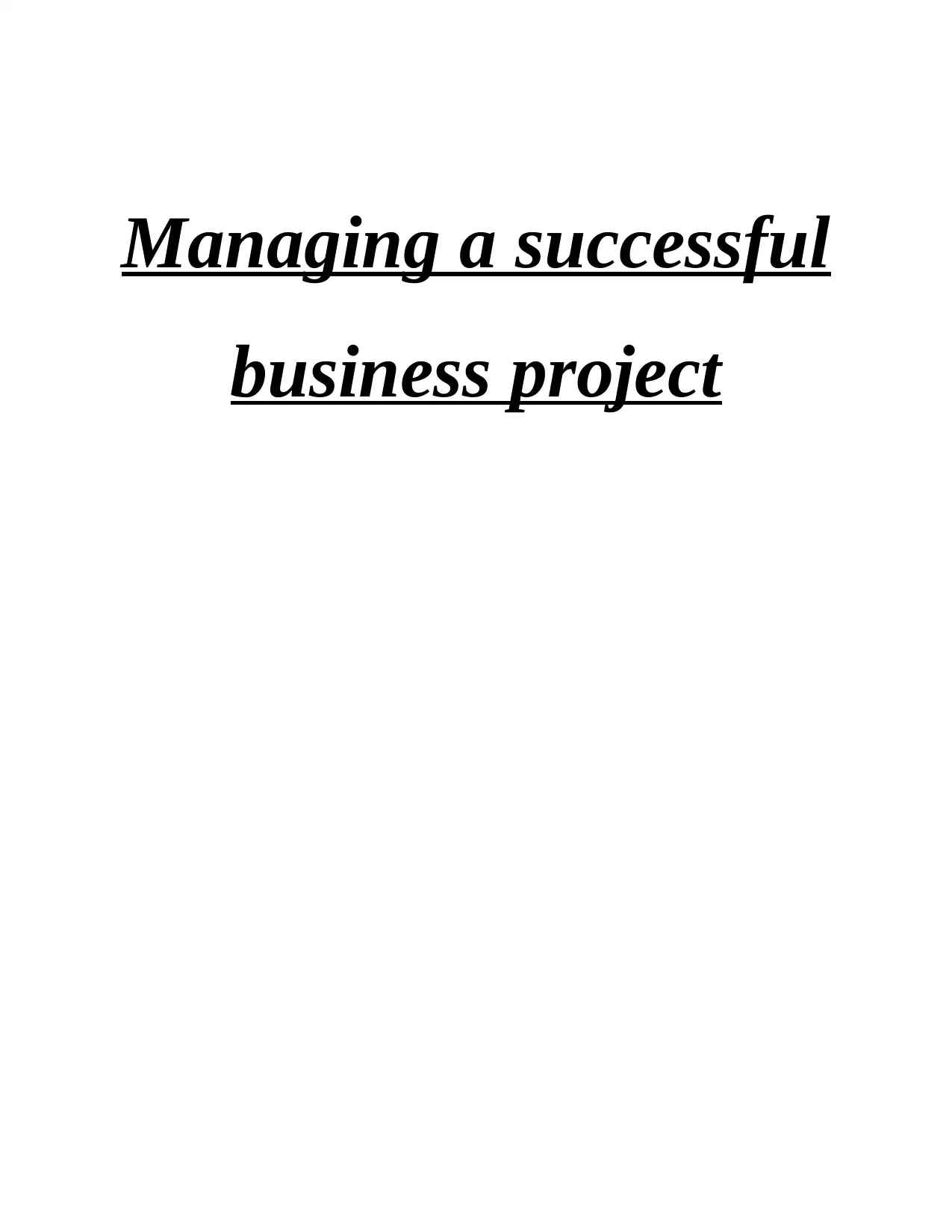
Managing a successful
business project
business project
Paraphrase This Document
Need a fresh take? Get an instant paraphrase of this document with our AI Paraphraser
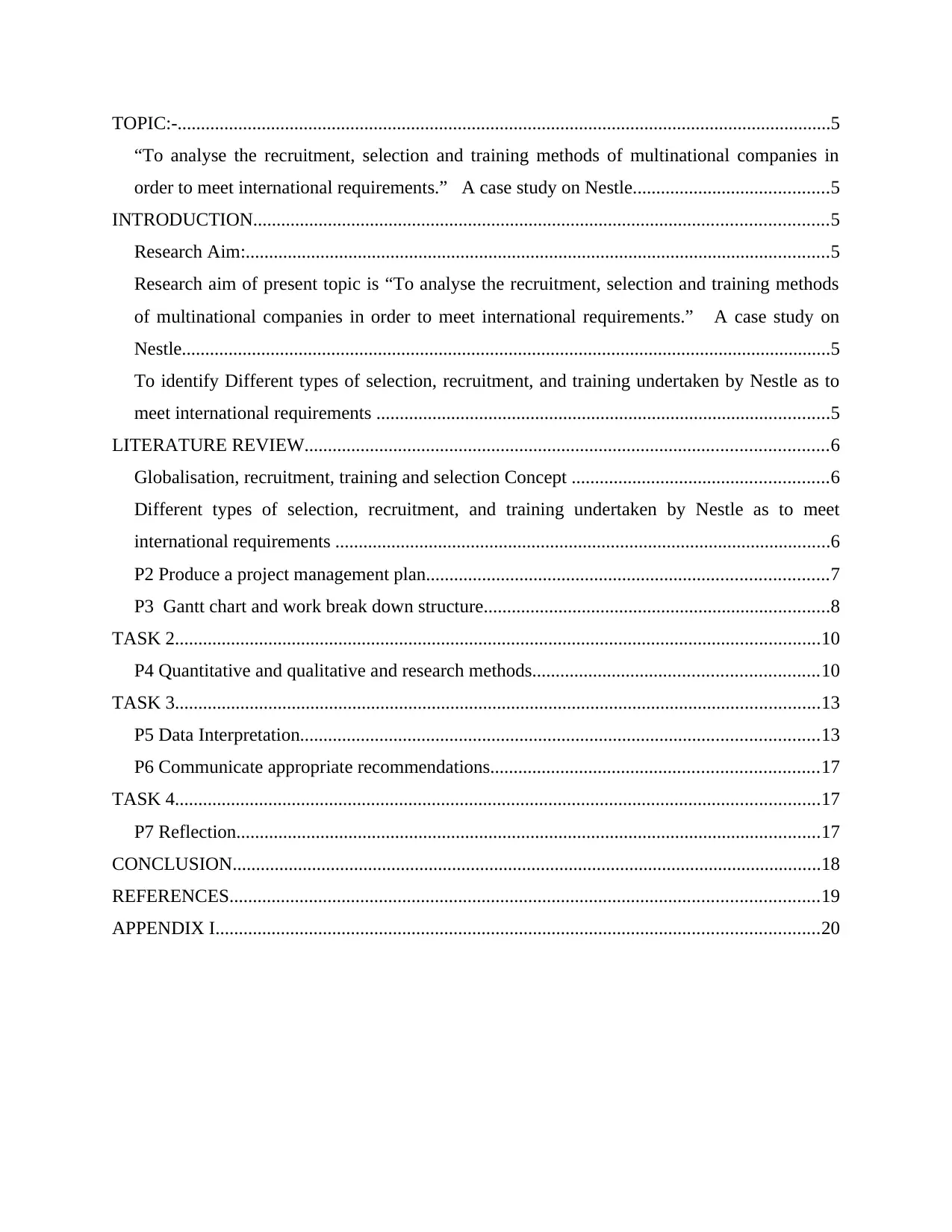
TOPIC:-............................................................................................................................................5
“To analyse the recruitment, selection and training methods of multinational companies in
order to meet international requirements.” A case study on Nestle..........................................5
INTRODUCTION...........................................................................................................................5
Research Aim:.............................................................................................................................5
Research aim of present topic is “To analyse the recruitment, selection and training methods
of multinational companies in order to meet international requirements.” A case study on
Nestle...........................................................................................................................................5
To identify Different types of selection, recruitment, and training undertaken by Nestle as to
meet international requirements .................................................................................................5
LITERATURE REVIEW................................................................................................................6
Globalisation, recruitment, training and selection Concept .......................................................6
Different types of selection, recruitment, and training undertaken by Nestle as to meet
international requirements ..........................................................................................................6
P2 Produce a project management plan......................................................................................7
P3 Gantt chart and work break down structure..........................................................................8
TASK 2..........................................................................................................................................10
P4 Quantitative and qualitative and research methods.............................................................10
TASK 3..........................................................................................................................................13
P5 Data Interpretation...............................................................................................................13
P6 Communicate appropriate recommendations......................................................................17
TASK 4..........................................................................................................................................17
P7 Reflection.............................................................................................................................17
CONCLUSION..............................................................................................................................18
REFERENCES..............................................................................................................................19
APPENDIX I.................................................................................................................................20
“To analyse the recruitment, selection and training methods of multinational companies in
order to meet international requirements.” A case study on Nestle..........................................5
INTRODUCTION...........................................................................................................................5
Research Aim:.............................................................................................................................5
Research aim of present topic is “To analyse the recruitment, selection and training methods
of multinational companies in order to meet international requirements.” A case study on
Nestle...........................................................................................................................................5
To identify Different types of selection, recruitment, and training undertaken by Nestle as to
meet international requirements .................................................................................................5
LITERATURE REVIEW................................................................................................................6
Globalisation, recruitment, training and selection Concept .......................................................6
Different types of selection, recruitment, and training undertaken by Nestle as to meet
international requirements ..........................................................................................................6
P2 Produce a project management plan......................................................................................7
P3 Gantt chart and work break down structure..........................................................................8
TASK 2..........................................................................................................................................10
P4 Quantitative and qualitative and research methods.............................................................10
TASK 3..........................................................................................................................................13
P5 Data Interpretation...............................................................................................................13
P6 Communicate appropriate recommendations......................................................................17
TASK 4..........................................................................................................................................17
P7 Reflection.............................................................................................................................17
CONCLUSION..............................................................................................................................18
REFERENCES..............................................................................................................................19
APPENDIX I.................................................................................................................................20

⊘ This is a preview!⊘
Do you want full access?
Subscribe today to unlock all pages.

Trusted by 1+ million students worldwide

4
Paraphrase This Document
Need a fresh take? Get an instant paraphrase of this document with our AI Paraphraser
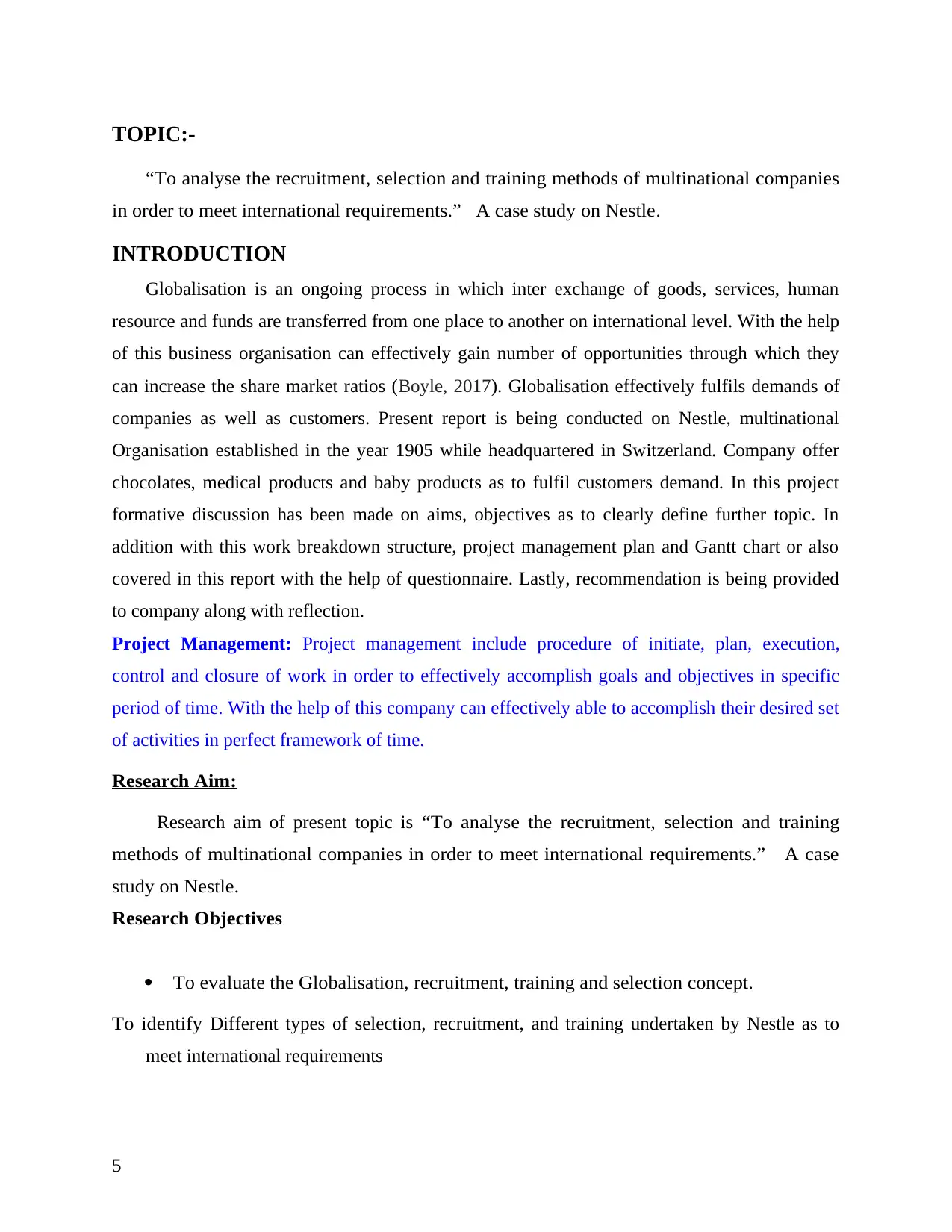
TOPIC:-
“To analyse the recruitment, selection and training methods of multinational companies
in order to meet international requirements.” A case study on Nestle.
INTRODUCTION
Globalisation is an ongoing process in which inter exchange of goods, services, human
resource and funds are transferred from one place to another on international level. With the help
of this business organisation can effectively gain number of opportunities through which they
can increase the share market ratios (Boyle, 2017). Globalisation effectively fulfils demands of
companies as well as customers. Present report is being conducted on Nestle, multinational
Organisation established in the year 1905 while headquartered in Switzerland. Company offer
chocolates, medical products and baby products as to fulfil customers demand. In this project
formative discussion has been made on aims, objectives as to clearly define further topic. In
addition with this work breakdown structure, project management plan and Gantt chart or also
covered in this report with the help of questionnaire. Lastly, recommendation is being provided
to company along with reflection.
Project Management: Project management include procedure of initiate, plan, execution,
control and closure of work in order to effectively accomplish goals and objectives in specific
period of time. With the help of this company can effectively able to accomplish their desired set
of activities in perfect framework of time.
Research Aim:
Research aim of present topic is “To analyse the recruitment, selection and training
methods of multinational companies in order to meet international requirements.” A case
study on Nestle.
Research Objectives
To evaluate the Globalisation, recruitment, training and selection concept.
To identify Different types of selection, recruitment, and training undertaken by Nestle as to
meet international requirements
5
“To analyse the recruitment, selection and training methods of multinational companies
in order to meet international requirements.” A case study on Nestle.
INTRODUCTION
Globalisation is an ongoing process in which inter exchange of goods, services, human
resource and funds are transferred from one place to another on international level. With the help
of this business organisation can effectively gain number of opportunities through which they
can increase the share market ratios (Boyle, 2017). Globalisation effectively fulfils demands of
companies as well as customers. Present report is being conducted on Nestle, multinational
Organisation established in the year 1905 while headquartered in Switzerland. Company offer
chocolates, medical products and baby products as to fulfil customers demand. In this project
formative discussion has been made on aims, objectives as to clearly define further topic. In
addition with this work breakdown structure, project management plan and Gantt chart or also
covered in this report with the help of questionnaire. Lastly, recommendation is being provided
to company along with reflection.
Project Management: Project management include procedure of initiate, plan, execution,
control and closure of work in order to effectively accomplish goals and objectives in specific
period of time. With the help of this company can effectively able to accomplish their desired set
of activities in perfect framework of time.
Research Aim:
Research aim of present topic is “To analyse the recruitment, selection and training
methods of multinational companies in order to meet international requirements.” A case
study on Nestle.
Research Objectives
To evaluate the Globalisation, recruitment, training and selection concept.
To identify Different types of selection, recruitment, and training undertaken by Nestle as to
meet international requirements
5
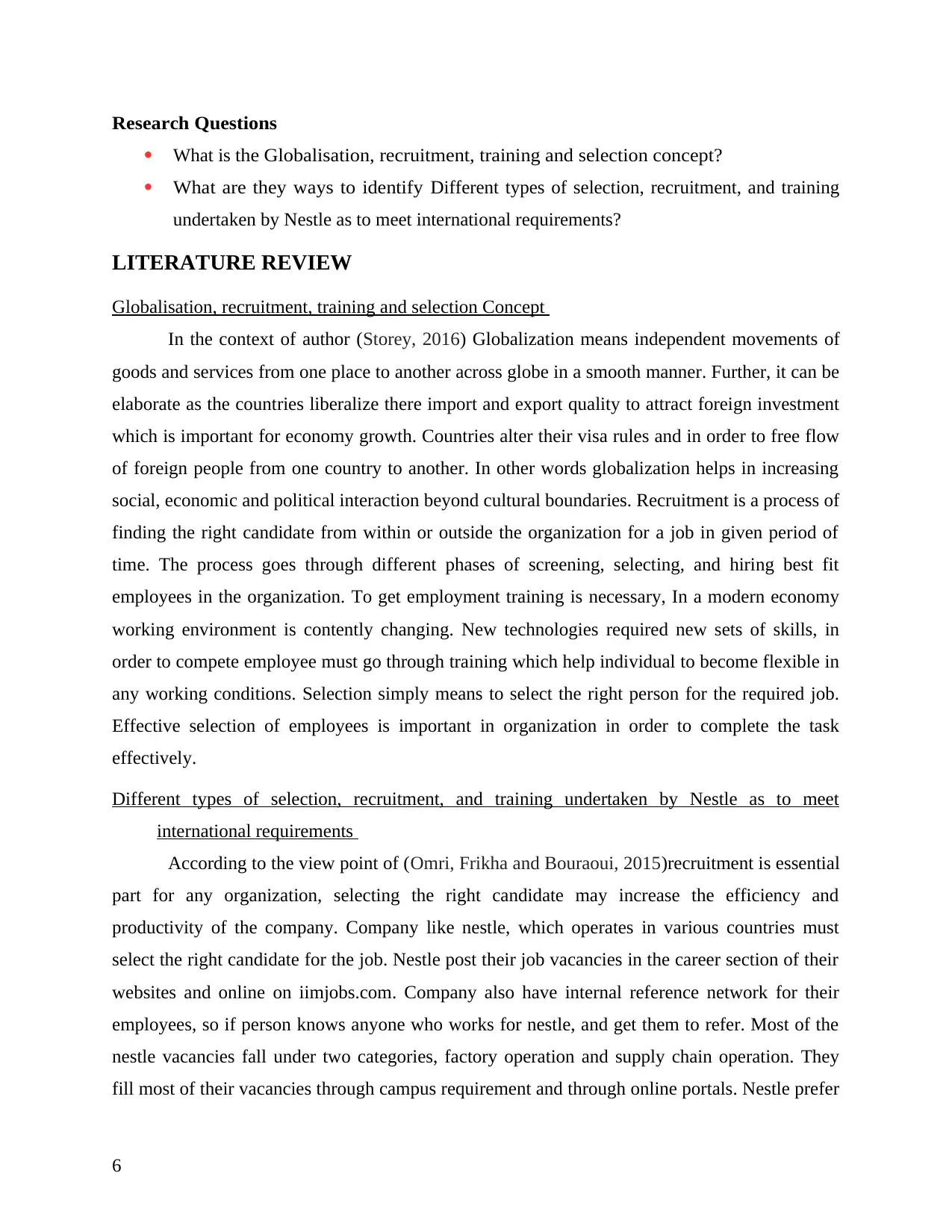
Research Questions
What is the Globalisation, recruitment, training and selection concept?
What are they ways to identify Different types of selection, recruitment, and training
undertaken by Nestle as to meet international requirements?
LITERATURE REVIEW
Globalisation, recruitment, training and selection Concept
In the context of author (Storey, 2016) Globalization means independent movements of
goods and services from one place to another across globe in a smooth manner. Further, it can be
elaborate as the countries liberalize there import and export quality to attract foreign investment
which is important for economy growth. Countries alter their visa rules and in order to free flow
of foreign people from one country to another. In other words globalization helps in increasing
social, economic and political interaction beyond cultural boundaries. Recruitment is a process of
finding the right candidate from within or outside the organization for a job in given period of
time. The process goes through different phases of screening, selecting, and hiring best fit
employees in the organization. To get employment training is necessary, In a modern economy
working environment is contently changing. New technologies required new sets of skills, in
order to compete employee must go through training which help individual to become flexible in
any working conditions. Selection simply means to select the right person for the required job.
Effective selection of employees is important in organization in order to complete the task
effectively.
Different types of selection, recruitment, and training undertaken by Nestle as to meet
international requirements
According to the view point of (Omri, Frikha and Bouraoui, 2015)recruitment is essential
part for any organization, selecting the right candidate may increase the efficiency and
productivity of the company. Company like nestle, which operates in various countries must
select the right candidate for the job. Nestle post their job vacancies in the career section of their
websites and online on iimjobs.com. Company also have internal reference network for their
employees, so if person knows anyone who works for nestle, and get them to refer. Most of the
nestle vacancies fall under two categories, factory operation and supply chain operation. They
fill most of their vacancies through campus requirement and through online portals. Nestle prefer
6
What is the Globalisation, recruitment, training and selection concept?
What are they ways to identify Different types of selection, recruitment, and training
undertaken by Nestle as to meet international requirements?
LITERATURE REVIEW
Globalisation, recruitment, training and selection Concept
In the context of author (Storey, 2016) Globalization means independent movements of
goods and services from one place to another across globe in a smooth manner. Further, it can be
elaborate as the countries liberalize there import and export quality to attract foreign investment
which is important for economy growth. Countries alter their visa rules and in order to free flow
of foreign people from one country to another. In other words globalization helps in increasing
social, economic and political interaction beyond cultural boundaries. Recruitment is a process of
finding the right candidate from within or outside the organization for a job in given period of
time. The process goes through different phases of screening, selecting, and hiring best fit
employees in the organization. To get employment training is necessary, In a modern economy
working environment is contently changing. New technologies required new sets of skills, in
order to compete employee must go through training which help individual to become flexible in
any working conditions. Selection simply means to select the right person for the required job.
Effective selection of employees is important in organization in order to complete the task
effectively.
Different types of selection, recruitment, and training undertaken by Nestle as to meet
international requirements
According to the view point of (Omri, Frikha and Bouraoui, 2015)recruitment is essential
part for any organization, selecting the right candidate may increase the efficiency and
productivity of the company. Company like nestle, which operates in various countries must
select the right candidate for the job. Nestle post their job vacancies in the career section of their
websites and online on iimjobs.com. Company also have internal reference network for their
employees, so if person knows anyone who works for nestle, and get them to refer. Most of the
nestle vacancies fall under two categories, factory operation and supply chain operation. They
fill most of their vacancies through campus requirement and through online portals. Nestle prefer
6
⊘ This is a preview!⊘
Do you want full access?
Subscribe today to unlock all pages.

Trusted by 1+ million students worldwide
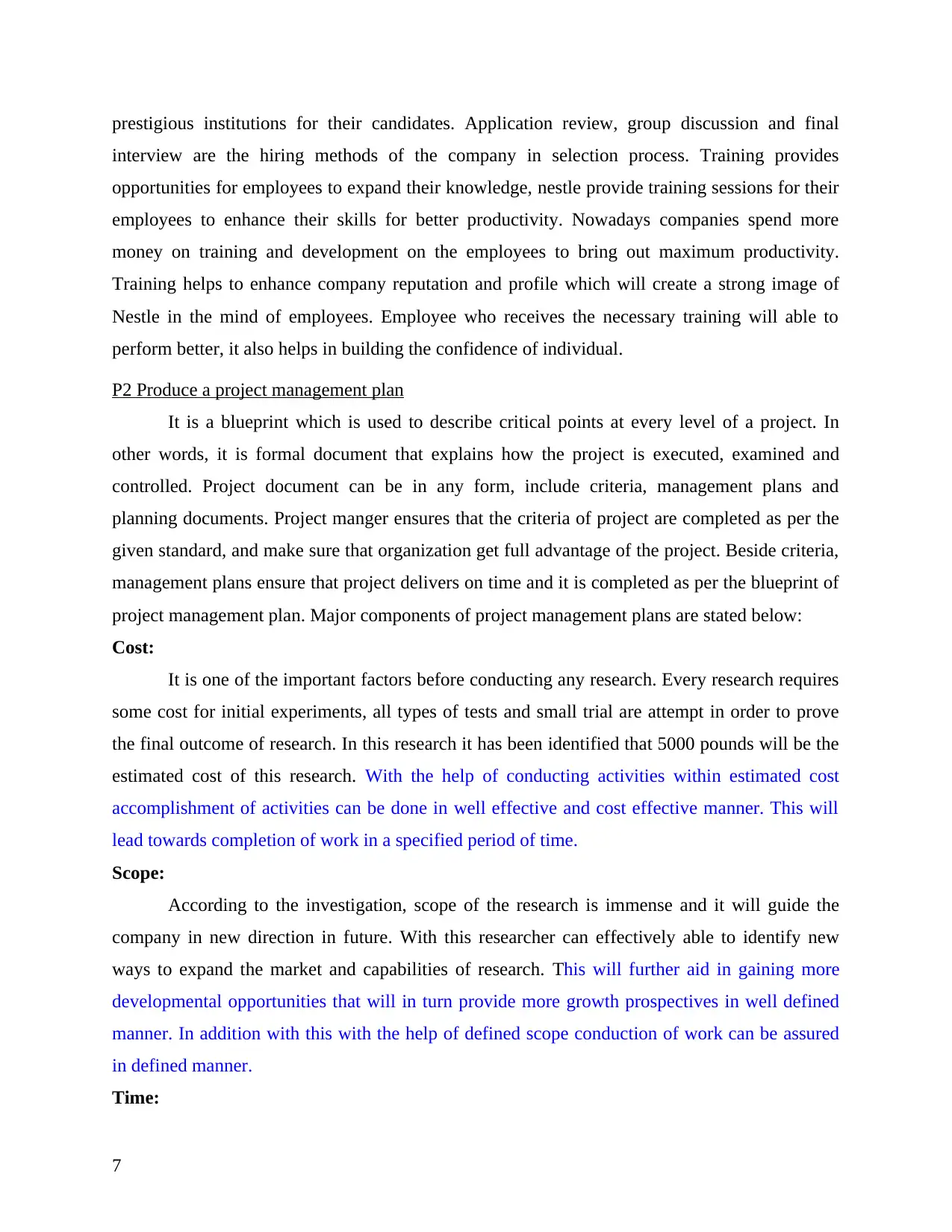
prestigious institutions for their candidates. Application review, group discussion and final
interview are the hiring methods of the company in selection process. Training provides
opportunities for employees to expand their knowledge, nestle provide training sessions for their
employees to enhance their skills for better productivity. Nowadays companies spend more
money on training and development on the employees to bring out maximum productivity.
Training helps to enhance company reputation and profile which will create a strong image of
Nestle in the mind of employees. Employee who receives the necessary training will able to
perform better, it also helps in building the confidence of individual.
P2 Produce a project management plan
It is a blueprint which is used to describe critical points at every level of a project. In
other words, it is formal document that explains how the project is executed, examined and
controlled. Project document can be in any form, include criteria, management plans and
planning documents. Project manger ensures that the criteria of project are completed as per the
given standard, and make sure that organization get full advantage of the project. Beside criteria,
management plans ensure that project delivers on time and it is completed as per the blueprint of
project management plan. Major components of project management plans are stated below:
Cost:
It is one of the important factors before conducting any research. Every research requires
some cost for initial experiments, all types of tests and small trial are attempt in order to prove
the final outcome of research. In this research it has been identified that 5000 pounds will be the
estimated cost of this research. With the help of conducting activities within estimated cost
accomplishment of activities can be done in well effective and cost effective manner. This will
lead towards completion of work in a specified period of time.
Scope:
According to the investigation, scope of the research is immense and it will guide the
company in new direction in future. With this researcher can effectively able to identify new
ways to expand the market and capabilities of research. This will further aid in gaining more
developmental opportunities that will in turn provide more growth prospectives in well defined
manner. In addition with this with the help of defined scope conduction of work can be assured
in defined manner.
Time:
7
interview are the hiring methods of the company in selection process. Training provides
opportunities for employees to expand their knowledge, nestle provide training sessions for their
employees to enhance their skills for better productivity. Nowadays companies spend more
money on training and development on the employees to bring out maximum productivity.
Training helps to enhance company reputation and profile which will create a strong image of
Nestle in the mind of employees. Employee who receives the necessary training will able to
perform better, it also helps in building the confidence of individual.
P2 Produce a project management plan
It is a blueprint which is used to describe critical points at every level of a project. In
other words, it is formal document that explains how the project is executed, examined and
controlled. Project document can be in any form, include criteria, management plans and
planning documents. Project manger ensures that the criteria of project are completed as per the
given standard, and make sure that organization get full advantage of the project. Beside criteria,
management plans ensure that project delivers on time and it is completed as per the blueprint of
project management plan. Major components of project management plans are stated below:
Cost:
It is one of the important factors before conducting any research. Every research requires
some cost for initial experiments, all types of tests and small trial are attempt in order to prove
the final outcome of research. In this research it has been identified that 5000 pounds will be the
estimated cost of this research. With the help of conducting activities within estimated cost
accomplishment of activities can be done in well effective and cost effective manner. This will
lead towards completion of work in a specified period of time.
Scope:
According to the investigation, scope of the research is immense and it will guide the
company in new direction in future. With this researcher can effectively able to identify new
ways to expand the market and capabilities of research. This will further aid in gaining more
developmental opportunities that will in turn provide more growth prospectives in well defined
manner. In addition with this with the help of defined scope conduction of work can be assured
in defined manner.
Time:
7
Paraphrase This Document
Need a fresh take? Get an instant paraphrase of this document with our AI Paraphraser
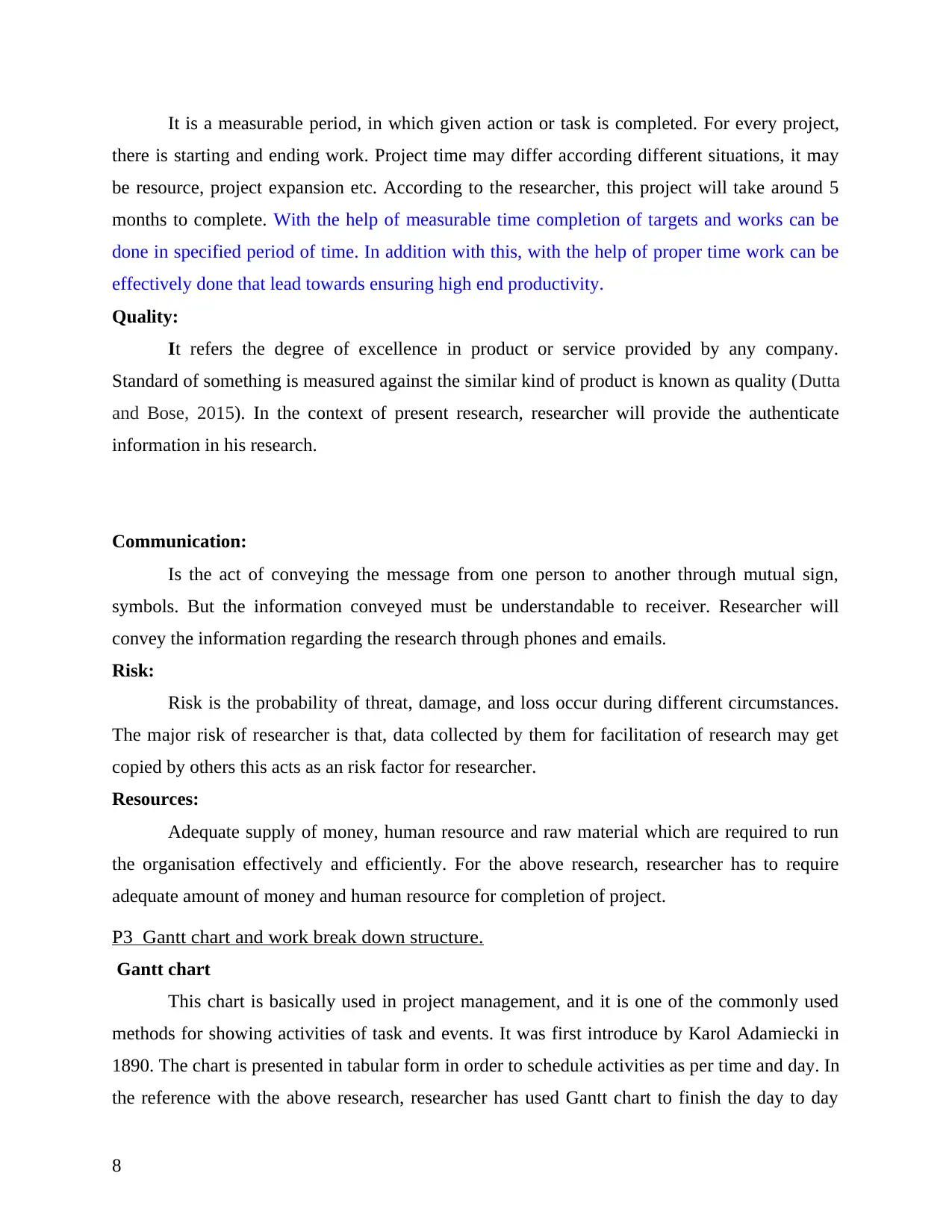
It is a measurable period, in which given action or task is completed. For every project,
there is starting and ending work. Project time may differ according different situations, it may
be resource, project expansion etc. According to the researcher, this project will take around 5
months to complete. With the help of measurable time completion of targets and works can be
done in specified period of time. In addition with this, with the help of proper time work can be
effectively done that lead towards ensuring high end productivity.
Quality:
It refers the degree of excellence in product or service provided by any company.
Standard of something is measured against the similar kind of product is known as quality (Dutta
and Bose, 2015). In the context of present research, researcher will provide the authenticate
information in his research.
Communication:
Is the act of conveying the message from one person to another through mutual sign,
symbols. But the information conveyed must be understandable to receiver. Researcher will
convey the information regarding the research through phones and emails.
Risk:
Risk is the probability of threat, damage, and loss occur during different circumstances.
The major risk of researcher is that, data collected by them for facilitation of research may get
copied by others this acts as an risk factor for researcher.
Resources:
Adequate supply of money, human resource and raw material which are required to run
the organisation effectively and efficiently. For the above research, researcher has to require
adequate amount of money and human resource for completion of project.
P3 Gantt chart and work break down structure.
Gantt chart
This chart is basically used in project management, and it is one of the commonly used
methods for showing activities of task and events. It was first introduce by Karol Adamiecki in
1890. The chart is presented in tabular form in order to schedule activities as per time and day. In
the reference with the above research, researcher has used Gantt chart to finish the day to day
8
there is starting and ending work. Project time may differ according different situations, it may
be resource, project expansion etc. According to the researcher, this project will take around 5
months to complete. With the help of measurable time completion of targets and works can be
done in specified period of time. In addition with this, with the help of proper time work can be
effectively done that lead towards ensuring high end productivity.
Quality:
It refers the degree of excellence in product or service provided by any company.
Standard of something is measured against the similar kind of product is known as quality (Dutta
and Bose, 2015). In the context of present research, researcher will provide the authenticate
information in his research.
Communication:
Is the act of conveying the message from one person to another through mutual sign,
symbols. But the information conveyed must be understandable to receiver. Researcher will
convey the information regarding the research through phones and emails.
Risk:
Risk is the probability of threat, damage, and loss occur during different circumstances.
The major risk of researcher is that, data collected by them for facilitation of research may get
copied by others this acts as an risk factor for researcher.
Resources:
Adequate supply of money, human resource and raw material which are required to run
the organisation effectively and efficiently. For the above research, researcher has to require
adequate amount of money and human resource for completion of project.
P3 Gantt chart and work break down structure.
Gantt chart
This chart is basically used in project management, and it is one of the commonly used
methods for showing activities of task and events. It was first introduce by Karol Adamiecki in
1890. The chart is presented in tabular form in order to schedule activities as per time and day. In
the reference with the above research, researcher has used Gantt chart to finish the day to day
8
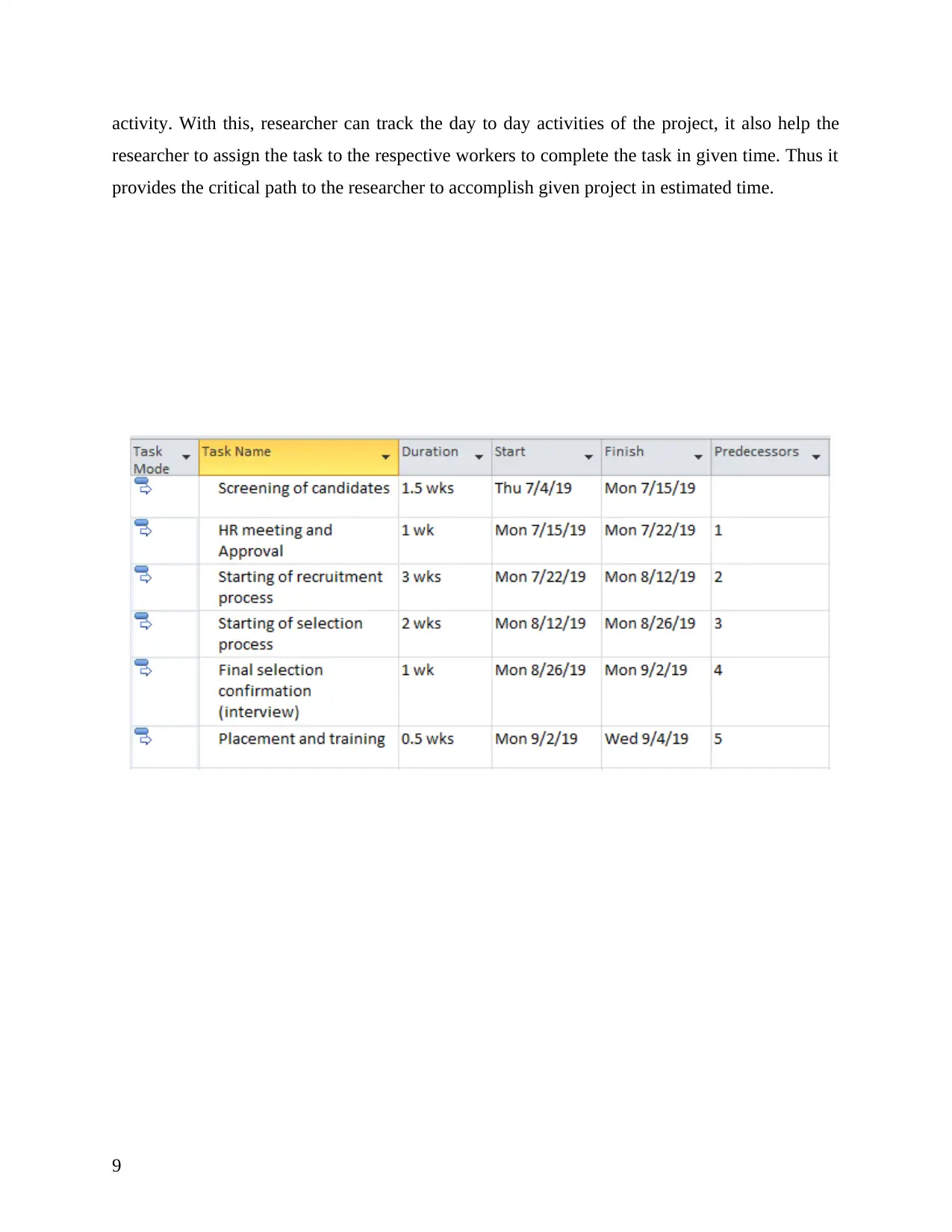
activity. With this, researcher can track the day to day activities of the project, it also help the
researcher to assign the task to the respective workers to complete the task in given time. Thus it
provides the critical path to the researcher to accomplish given project in estimated time.
9
researcher to assign the task to the respective workers to complete the task in given time. Thus it
provides the critical path to the researcher to accomplish given project in estimated time.
9
⊘ This is a preview!⊘
Do you want full access?
Subscribe today to unlock all pages.

Trusted by 1+ million students worldwide
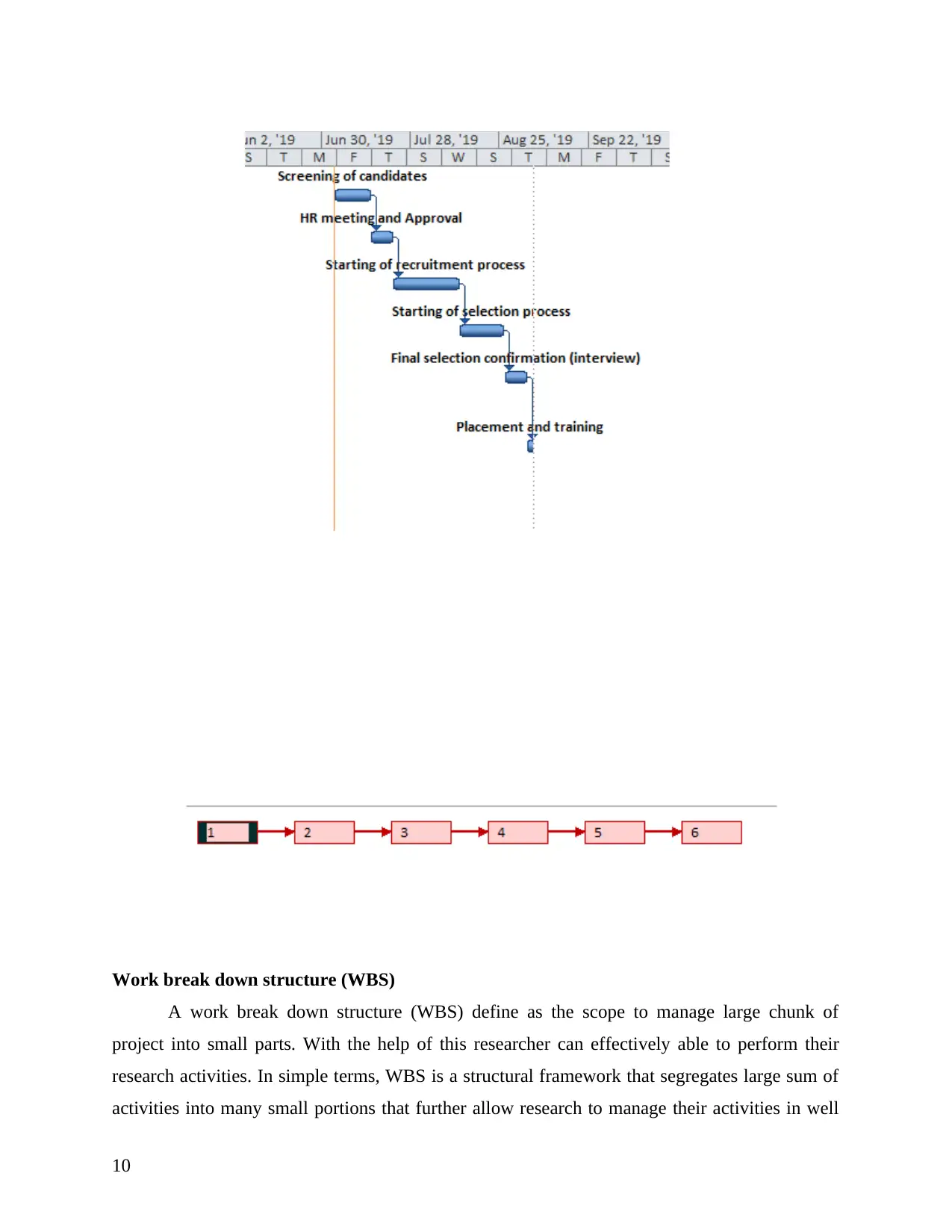
Work break down structure (WBS)
A work break down structure (WBS) define as the scope to manage large chunk of
project into small parts. With the help of this researcher can effectively able to perform their
research activities. In simple terms, WBS is a structural framework that segregates large sum of
activities into many small portions that further allow research to manage their activities in well
10
A work break down structure (WBS) define as the scope to manage large chunk of
project into small parts. With the help of this researcher can effectively able to perform their
research activities. In simple terms, WBS is a structural framework that segregates large sum of
activities into many small portions that further allow research to manage their activities in well
10
Paraphrase This Document
Need a fresh take? Get an instant paraphrase of this document with our AI Paraphraser
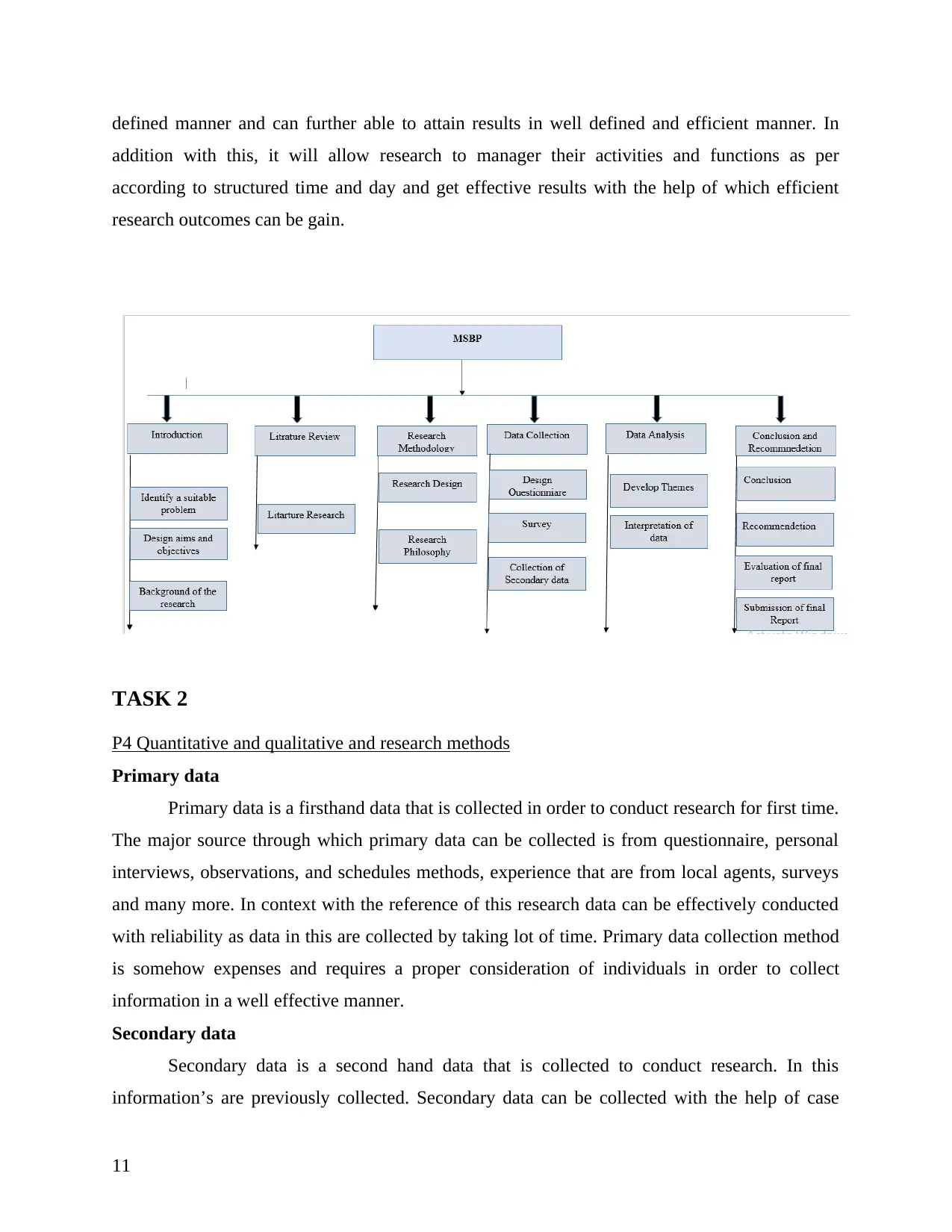
defined manner and can further able to attain results in well defined and efficient manner. In
addition with this, it will allow research to manager their activities and functions as per
according to structured time and day and get effective results with the help of which efficient
research outcomes can be gain.
TASK 2
P4 Quantitative and qualitative and research methods
Primary data
Primary data is a firsthand data that is collected in order to conduct research for first time.
The major source through which primary data can be collected is from questionnaire, personal
interviews, observations, and schedules methods, experience that are from local agents, surveys
and many more. In context with the reference of this research data can be effectively conducted
with reliability as data in this are collected by taking lot of time. Primary data collection method
is somehow expenses and requires a proper consideration of individuals in order to collect
information in a well effective manner.
Secondary data
Secondary data is a second hand data that is collected to conduct research. In this
information’s are previously collected. Secondary data can be collected with the help of case
11
addition with this, it will allow research to manager their activities and functions as per
according to structured time and day and get effective results with the help of which efficient
research outcomes can be gain.
TASK 2
P4 Quantitative and qualitative and research methods
Primary data
Primary data is a firsthand data that is collected in order to conduct research for first time.
The major source through which primary data can be collected is from questionnaire, personal
interviews, observations, and schedules methods, experience that are from local agents, surveys
and many more. In context with the reference of this research data can be effectively conducted
with reliability as data in this are collected by taking lot of time. Primary data collection method
is somehow expenses and requires a proper consideration of individuals in order to collect
information in a well effective manner.
Secondary data
Secondary data is a second hand data that is collected to conduct research. In this
information’s are previously collected. Secondary data can be collected with the help of case
11
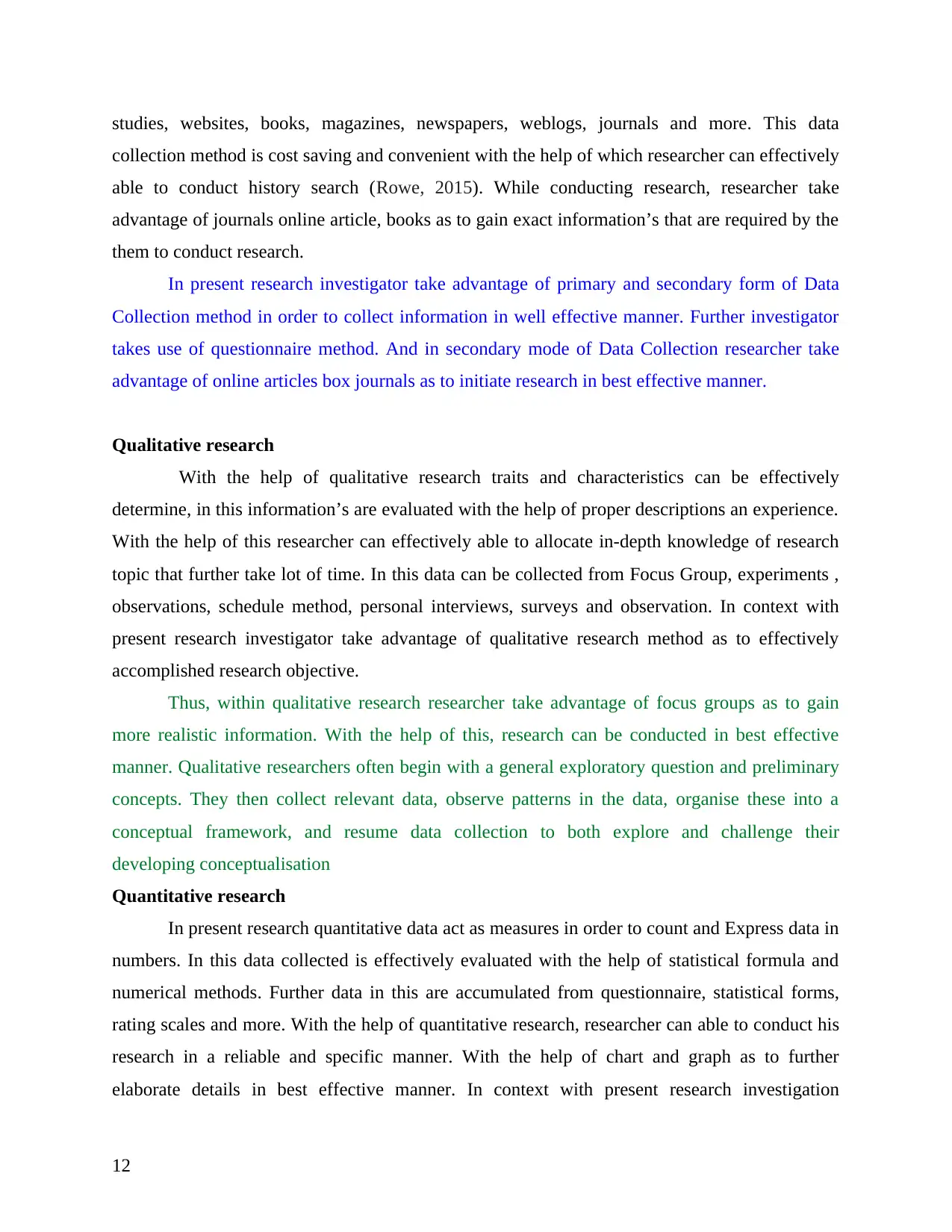
studies, websites, books, magazines, newspapers, weblogs, journals and more. This data
collection method is cost saving and convenient with the help of which researcher can effectively
able to conduct history search (Rowe, 2015). While conducting research, researcher take
advantage of journals online article, books as to gain exact information’s that are required by the
them to conduct research.
In present research investigator take advantage of primary and secondary form of Data
Collection method in order to collect information in well effective manner. Further investigator
takes use of questionnaire method. And in secondary mode of Data Collection researcher take
advantage of online articles box journals as to initiate research in best effective manner.
Qualitative research
With the help of qualitative research traits and characteristics can be effectively
determine, in this information’s are evaluated with the help of proper descriptions an experience.
With the help of this researcher can effectively able to allocate in-depth knowledge of research
topic that further take lot of time. In this data can be collected from Focus Group, experiments ,
observations, schedule method, personal interviews, surveys and observation. In context with
present research investigator take advantage of qualitative research method as to effectively
accomplished research objective.
Thus, within qualitative research researcher take advantage of focus groups as to gain
more realistic information. With the help of this, research can be conducted in best effective
manner. Qualitative researchers often begin with a general exploratory question and preliminary
concepts. They then collect relevant data, observe patterns in the data, organise these into a
conceptual framework, and resume data collection to both explore and challenge their
developing conceptualisation
Quantitative research
In present research quantitative data act as measures in order to count and Express data in
numbers. In this data collected is effectively evaluated with the help of statistical formula and
numerical methods. Further data in this are accumulated from questionnaire, statistical forms,
rating scales and more. With the help of quantitative research, researcher can able to conduct his
research in a reliable and specific manner. With the help of chart and graph as to further
elaborate details in best effective manner. In context with present research investigation
12
collection method is cost saving and convenient with the help of which researcher can effectively
able to conduct history search (Rowe, 2015). While conducting research, researcher take
advantage of journals online article, books as to gain exact information’s that are required by the
them to conduct research.
In present research investigator take advantage of primary and secondary form of Data
Collection method in order to collect information in well effective manner. Further investigator
takes use of questionnaire method. And in secondary mode of Data Collection researcher take
advantage of online articles box journals as to initiate research in best effective manner.
Qualitative research
With the help of qualitative research traits and characteristics can be effectively
determine, in this information’s are evaluated with the help of proper descriptions an experience.
With the help of this researcher can effectively able to allocate in-depth knowledge of research
topic that further take lot of time. In this data can be collected from Focus Group, experiments ,
observations, schedule method, personal interviews, surveys and observation. In context with
present research investigator take advantage of qualitative research method as to effectively
accomplished research objective.
Thus, within qualitative research researcher take advantage of focus groups as to gain
more realistic information. With the help of this, research can be conducted in best effective
manner. Qualitative researchers often begin with a general exploratory question and preliminary
concepts. They then collect relevant data, observe patterns in the data, organise these into a
conceptual framework, and resume data collection to both explore and challenge their
developing conceptualisation
Quantitative research
In present research quantitative data act as measures in order to count and Express data in
numbers. In this data collected is effectively evaluated with the help of statistical formula and
numerical methods. Further data in this are accumulated from questionnaire, statistical forms,
rating scales and more. With the help of quantitative research, researcher can able to conduct his
research in a reliable and specific manner. With the help of chart and graph as to further
elaborate details in best effective manner. In context with present research investigation
12
⊘ This is a preview!⊘
Do you want full access?
Subscribe today to unlock all pages.

Trusted by 1+ million students worldwide
1 out of 27
Related Documents
Your All-in-One AI-Powered Toolkit for Academic Success.
+13062052269
info@desklib.com
Available 24*7 on WhatsApp / Email
![[object Object]](/_next/static/media/star-bottom.7253800d.svg)
Unlock your academic potential
Copyright © 2020–2025 A2Z Services. All Rights Reserved. Developed and managed by ZUCOL.





